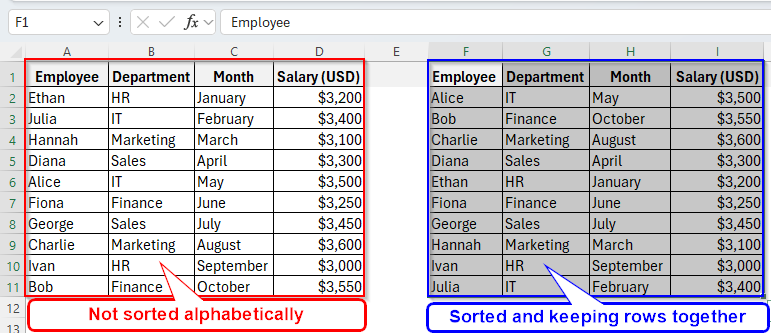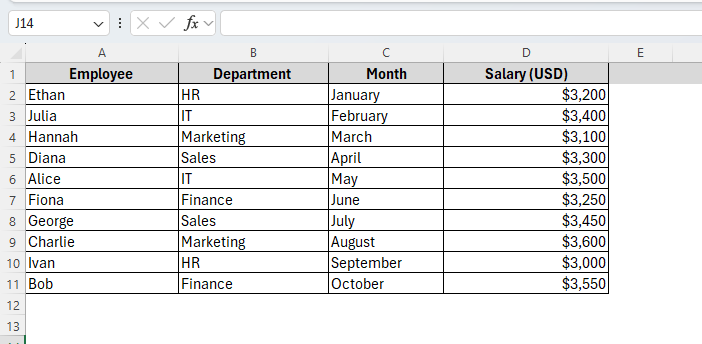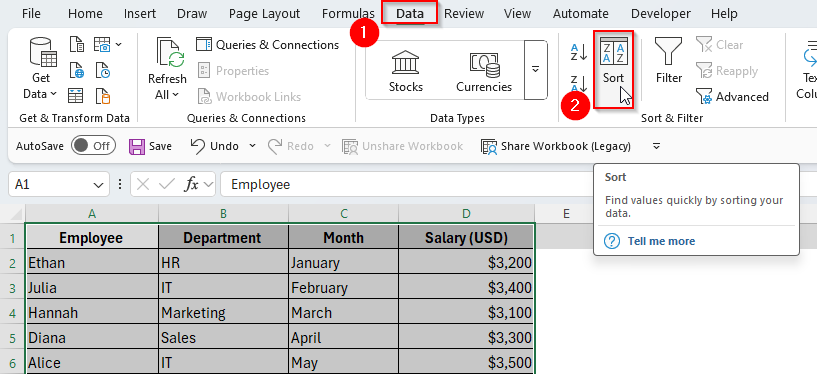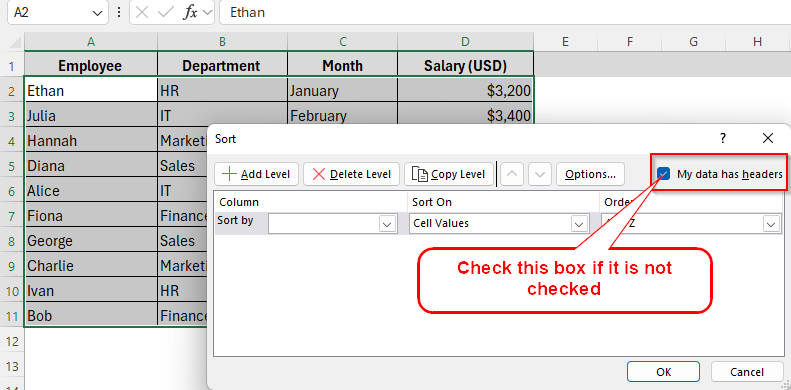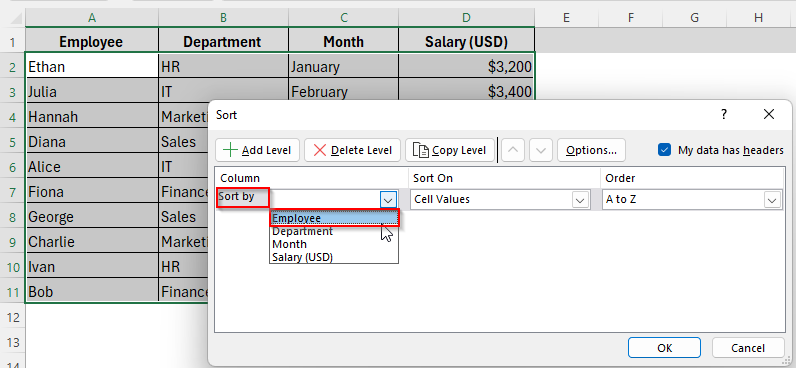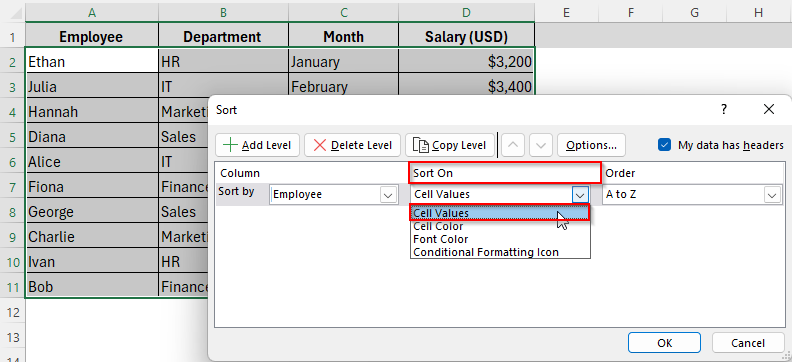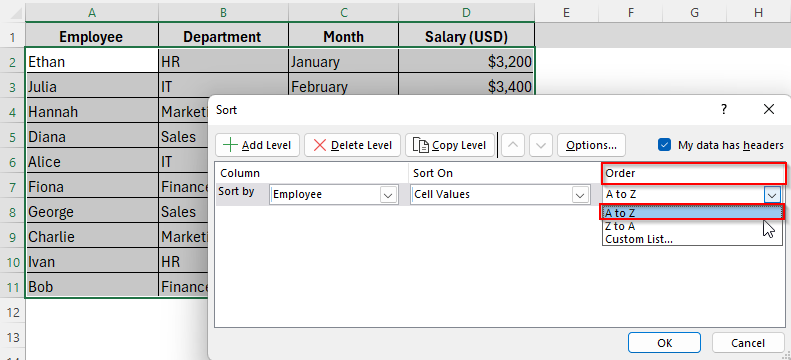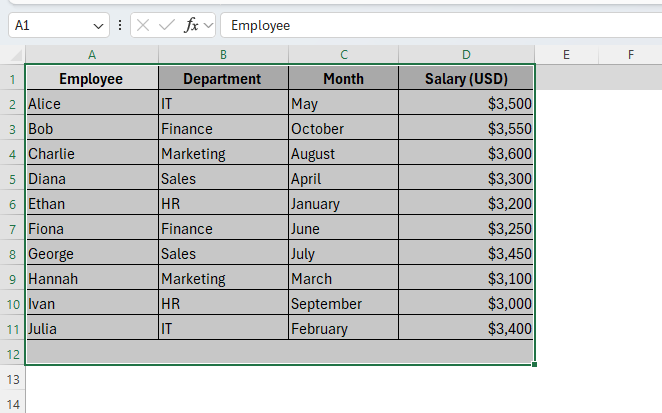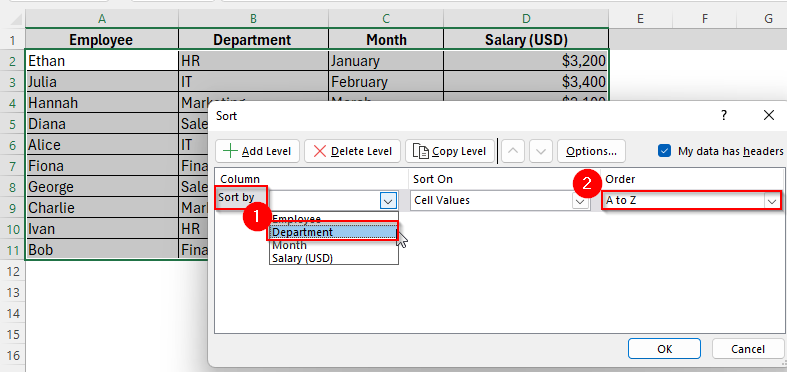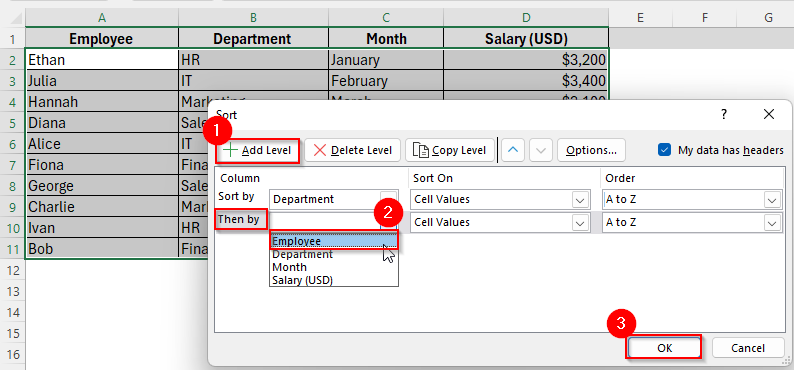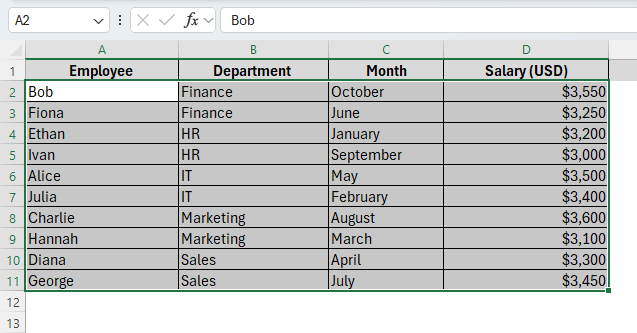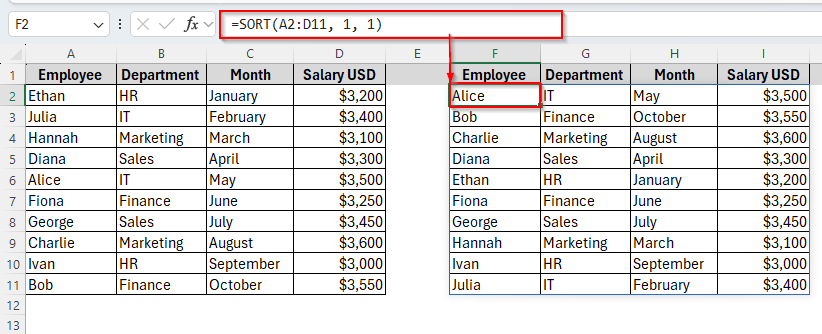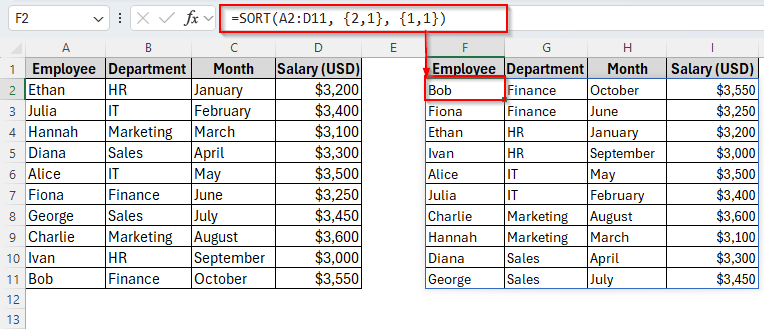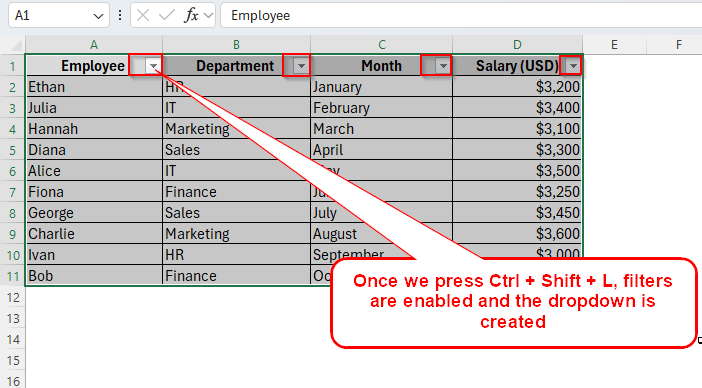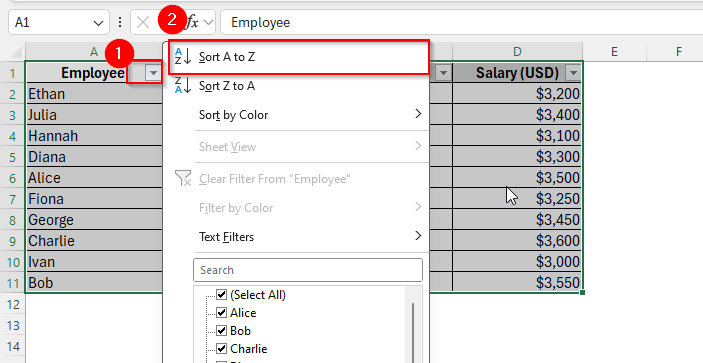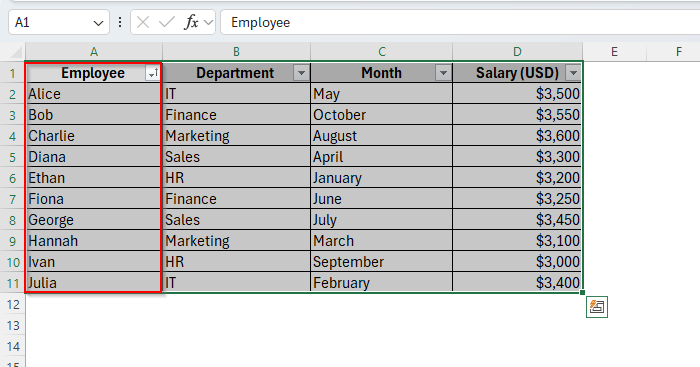Excel offers us various useful features to sort data alphabetically. But with the basic steps, sometimes you may end up with some mismatched data. Like someone’s name can be paired with the wrong department or joining year. It happens when you sort just one column instead of the whole row. That’s why it’s important to sort alphabetically while keeping the rows together.
So, in this guide, we’ll show you how to sort alphabetically in Excel the right way, without messing up your data. Whether it’s a product list, employee records, or customer info, these methods will help you keep everything in order.
Steps to sort alphabetically and keep rows together by using Excel’s built-in Sort feature:
➤ Select all the cells in your dataset.
➤ Go to Data > Sort.
➤ Check My data has headers.
➤ In the Sort by dropdown, select Employee.
➤ In the Sort on dropdown, select Values.
➤ In the Order dropdown, choose A to Z.
➤ Click OK.
This will sort the Employee name alphabetically in the Column A but still keeping the rows intact. Now, let’s dive into the step-by-step methods and learn how to do it the right way.
Using Sort Tool to Sort a Column Alphabetically and Keep Rows Together
Using the Data tab to sort alphabetically in Excel is a reliable method that keeps your entire dataset organized. When you sort a specific column from the Data tab, Excel ensures that all corresponding rows stay intact, preventing mismatched data. Sorting this way works for both ascending (A to Z) and descending (Z to A) orders. This would be the most common and beginner-friendly method to sort data in Excel while keeping the rows intact.
Here, we have the following dataset including Employee, Department, Month and their Salary. Now, we want to sort the Column A (Employee) alphabetically, but keep the Department, Month and Salary data connected to the correct person.
Let’s see how we can do so with some very simple steps using Data Tab.
Steps:
➤ To begin with, select all the cells in the dataset.
➤ Now choose Data > Sort.
➤ As we’ve headers in the dataset, ensure My data has headers section is checked.
➤ Now in the Sort by dropdown, choose the column Employee.
➤ In the Sort on dropdown, select Cell Values.
➤ Lastly, in the Order dropdown, select A to Z.
➤ Finally, click OK and you can see that the rows are now reordered alphabetically by Employee, and each row’s Department, Month and Salary stay attached to the correct Employee.
Sorting Multiple Columns Alphabetically But Keeping Rows Together
Well, this method is useful when we want to sort by multiple columns like first by Department, then alphabetically by Employee within each Department. This keeps related items grouped together and makes your list easier to read. It’s different from sorting just one column because it follows more than one rule, not just A to Z in one column.
This method is great when you have a large table and want to keep everything neat and grouped properly. Now, here we’ll sort both the Column A and Column B alphabetically while keeping rows intact.
Steps:
➤ Select the full dataset.
➤ Click Sort from the Data tab.
➤ In the Sort dialog, under Sort by, select Department and choose A to Z.
➤ Click Add Level and under Then by, select Employee, also A to Z.
➤ By clicking OK, now your data is grouped by Department and sorted alphabetically within each group as we can see in the image below.
Inserting SORT Function to Sort Multiple Columns and Rows Together
Using the SORT function in Excel lets you sort multiple columns and rows together with a formula, rather than using the Data tab. It’s especially useful when you want your sorted list to appear in a new location, without changing the original data. It is because the SORT function in Excel is basically a dynamic function.
Normally when we put a function in excel we get the result of the function in that same cell. But in a dynamic function, we get the result in the cell and also the following cells below it. This method is more flexible than manual sorting but works best for simpler datasets.
However, here our data is in the range A1:D11 including the headers. Now we’ll use the SORT function to sort by one or more columns while keeping all rows together. And as we’ll get the result in a new location, we’ll have to create a new table for the dataset in the range F1:I11 including the headers. Copy the headers in F1 and put the formula in F2.
Sorting One Column with the SORT Function
Firstly, we’re going to sort the full dataset alphabetically by the Employee. So, our data range will be A2:D11 excluding headers. And here are the steps to follow.
Steps:
➤ Insert the following formula in the cell F2:
=SORT(A2:D11, 1, 1)
Here, 1 refers to the first column (Employee) and the next 1 means ascending. If you want to sort by descending, insert -1.
➤ Press Enter. The dataset will be sorted accordingly as we can see in the image below.
Sorting Multiple Columns with the SORT Function
Now we’ll sort by multiple columns including Employee and Department name. Let’s see how it works.
➤ Choose the F2 cell and insert the formula as follows:
=SORT(A2:D11, {2,1}, {1,1})
➤ Hit Enter and as we can see below, the dataset is sorted by the two different columns while the rows keep together.
Sorting Alphabetically with Filters While Keeping Rows Intact
Another simple method to sort alphabetically but ensuring the rows are not affected is using the Filters in Excel. But it is just a temporary view. Filters can help you temporarily sort without changing the actual structure of your spreadsheet.
Steps:
➤ Select the dataset including headers.
➤ Press Ctrl + Shift + L to enable filters.
➤ Click the dropdown in the column header.
➤ Select Sort A to Z.
➤ Now as we can see in the following image, the columns have been sorted alphabetically but the rows are still together.
Frequently Asked Questions
Why Don’t My Rows Keep Together When I Sort Then Alphabetically?
The key reason for this problem is that you may have selected only one column before sorting. Excel will reorder that column while leaving the others untouched, which breaks row alignment. To prevent this, always highlight the entire table or dataset before sorting.
Will Sorting Still Work if My Data Has Merged Cells?
Unfortunately it won’t. Excel doesn’t allow sorting with merged cells. You’ll need to unmerge cells before sorting, or restructure your data.
Can I Sort a PivotTable Alphabetically and Keep Rows Together?
Yes, you can. In a PivotTable, firstly, right click on a row label and then go to Sort > Sort A to Z. Excel will keep the related values together automatically.
Concluding Words
Sorting alphabetically in Excel is more than just a simple A-to-Z click. To keep your data accurate and useful, it’s critical to sort the entire table or range, not just one column. Try using the SORT function for dynamic sorting or the custom sort dialog for more control. Now that you know how to do it right, your data will always stay organized and intact.

